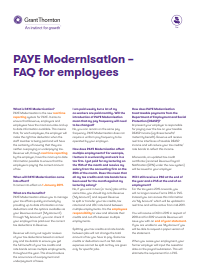What is PAYE Modernisation?
PAYE Modernisation is the new real-time reporting system for PAYE. It aims to ensure that Revenue, employers and employees have the most accurate and up to date information available. This means that, for each employee, the employer will make the right tax deduction when the staff member is being paid and will have the certainty of knowing that they are neither overpaying or underpaying tax. Revenue will, through real-time reporting by the employer, have the most up to date information possible to ensure that the employee is paying the correct amount of tax.
When will PAYE Modernisation come into effect?
PAYE Modernistion comes into effect on 1 January 2019.
What are the benefits?
PAYE Modernisation allows you to manage your tax affairs quickly and easily by providing up to date information on tax deductions and the options available via your Revenue account (‘My Account’). Through ‘My Account’, you can check if your employer has paid over the correct tax deductions to Revenue. Revenue will carry out regular reviews of your tax deductions based on actual pay and tax details to ensure you get the full benefit of your tax credits and rate bands across multiple employments, throughout the year. This should reduce the occurrence of overpayment and underpayment of taxes.
Will I still receive a P60 at the end of the year and a P45 at the end of an employment?
For the tax years 2019 onwards, you will no longer receive Forms P60 or P45. Instead you can access this information via ‘My Account’ which will be updated in real time and will be active from mid-2019. You will receive a P60 in 2019 in respect of 2018 and for 2019 onwards Revenue will issue you with an end of year statement. If you are unable to use ‘My Account’ you will be able to request a paper version of the statement. When you cease your employment, your former employer will input the cessation date on the payroll submission. This will eliminate the requirement for a P45. Tax You will no longer need to provide a copy of your P45 to your new employer. Instead, you will confirm your PPS number to your new employer who will notify Revenue of your start date. This will create a new employment record with Revenue and allow your employer to access your up to date credits and rate bands.
The impact of PAYE Modernisation have on emergency tax
Your employer must operate emergency tax on your employment income where they do not receive a RPN from Revenue.
A RPN will not be issued where you have not:
- given your employer your PPS number or;
- registered for PAYE. When you start working in Ireland for the first time, you must register this employment with Revenue. This can be done through ‘My Account’.
The emergency tax rates are as follows:
- where you have not given your PPS number to your employer, all of your income is taxed at the higher rate (40% income tax and 8% Universal Social Charge (USC));
- where your employer does not have a RPN, you may give your employer your PPS number, but if you are not registered for PAYE your employer will not receive a RPN. You will receive a single person’s rate band for the first four weeks. This means that in the first four weeks your weekly income:
- up to €665 will be taxed at the standard rate of tax (20%);
- over €665 will be taxed at the higher rate (40%);
- after four weeks your total income will be taxed at 40%; and
- the emergency rate of USC is 8% on all income.




